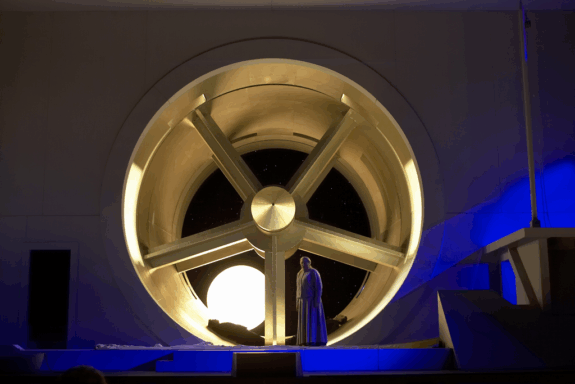 Germany Wagner, Tristan und Isolde: Soloists and Chorus of Hamburg State Opera, Hamburg Philharmonic State Orchestra / Kent Nagano (conductor). Hamburg, 15.6.2025. (DM-D)
Germany Wagner, Tristan und Isolde: Soloists and Chorus of Hamburg State Opera, Hamburg Philharmonic State Orchestra / Kent Nagano (conductor). Hamburg, 15.6.2025. (DM-D)

Production:
Director – Ruth Berghaus
Revival director – Petra Müller
Set design – Hans-Dieter Schaal
Costume and Props design – Marie-Louise Strandt
Dramaturgy – Sigrid Neef
Chorus director – Christian Günther
Cast:
Tristan – Simon O’Neill
Isolde – Catherine Foster
Kurwenal – Christoph Pohl
King Marke – René Pape
Brangäne – Katja Piewek
Melot – William Desbiens
Voice of a Young Sailor / A Shepherd – Aaron Godfrey-Mayes
A Steersman – Grzegorz Pelutis
This production was premiered in Hamburg in 1988, when famous director Ruth Berghaus was still a citizen of the ‘German Democratic Republic’ and dramaturg Sigrid Neef was spying on her for the ‘Stasi’ state security ministry, as was later revealed. The production has now been revived and the performance I saw was the 52nd overall.
No wonder the visual impact was so strong, considering the monumental size of the set by Hans-Dieter Schaal. I believe the unusually long intervals of 40 minutes each were needed to change the sets from Act I to Act II and from Act II to Act III. The stage space was delimited for the beginning of each act, and for the end of Act III, by an ivory-coloured wooden frame surrounding a scene from outer space, with moon-like asteroid towards the front, and a further two, smaller planets further towards the back in a constellation resembling the Milky Way. After the overture and after the introductions to the second and third acts, that frame was lifted and revealed the setting: for Act I, it was a view of part of a ship’s engine and what looked like a deck on board a cruise ship, with many deck chairs, all in shades of grey. Brangäne sought to keep some kind of order, repositioning the chairs when they had been moved to different positions by the sailors, who were at times lying under them or sitting on them. For Act II, the stage was dominated by a huge turbine, with two wheels of spokes turning slowly, at times, in opposite directions. For much of the love duet (‘Sink hernieder’) Tristan and Isolde positioned themselves on one of the spokes, allowing themselves to be carried by the wheel. Act III opened to a huge globe, almost centre-stage, with a slightly tilted plane to the left and a considerably tilted plane towards the right (here the angle meant those moving about on it had to support themselves with ropes). Beautiful effects of lighting were created particularly towards the end of the opera, for Isolde’s ‘Mild und leise’, in relation to the globe. After the final notes of Isolde’s singing, the frontispiece from outer space was lowered and Isolde embraced the moon/asteroid. Overall, the production came across as demanding, even if it may not be possible (or necessary!) to make sense of every single nuance of it. It had all the marks of the professional assurance characteristic of an accomplished, well-experienced director.

It was remarkable how well Catherine Foster as Isolde was able to mould both her acting and her singing to the production, so different in approach to the recent Cottbus one (see review here). While in Cottbus the production placed emphasis on Isolde first and foremost as a young strawberry blonde woman, in Hamburg she was a black-haired lady of authority, or power, of fierce energy and considerable passion, all the more intense since she was frustrated. While long, ‘feminine’ arcs of singing were at the fore of the Cottbus rendering, Foster here offered nuances of ferocious energy, with just as much precision of technique and beauty of tone.
Simon O’Neill sang Tristan. He was able to pace his energy and maintain the stamina to carry him through the opera. When the voice was open, it sounded very beautiful indeed. It was not always open, however, so when it was not, particularly in the higher register, the sound turned nasal, squeezed, more like that of a character tenor than a Heldentenor, and occasionally came across as uncomfortable.
Katja Piewek has sung Brangäne in several revivals of this production; hers was a particularly concerned, gentle and loving – though not at all maternal – take on the role, establishing a particularly strong vocal contrast to Foster’s Isolde. Piewek’s secure, mellow mezzo-soprano voice was very well suited to this interpretation. René Pape brought out King Marke’s nobility, and the depths of sadness, surprise, disbelief and regret, again both through his acting and his peerless voice. Compared with this live performance, many recordings across various media do not manage to carry the quality of that amazing bass voice; its richness, its technique, its range and colour. Christoph Pohl was more than reliable as Kurwenal, with a robust but warm baritone and a particularly strong lower range. William Desbiens as Melot, Aaron Godfrey-Mayes as the Shepherd and the Voice of the Young Sailor, and Grzegorz Pelutis as the Steersman demonstrated the high level of achievement of members of the International Opera Studio at Staatsoper Hamburg.
This performance was the last time Kent Nagano conducted an opera at this opera house as its General Music Director (which he has been since 2015). The music sounded ethereal overall, finely wrought, filigree, without ever giving way to being, or becoming, aloof. Emotions were grounded, earthy, pithy, and on that very basis the rare added dimension of something approximating spirituality shone through.
Daniel Meyer-Dinkgräfe
